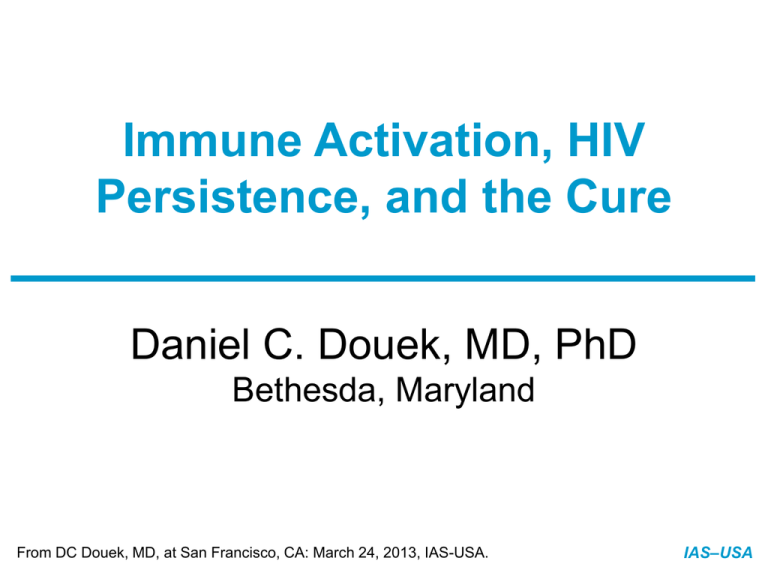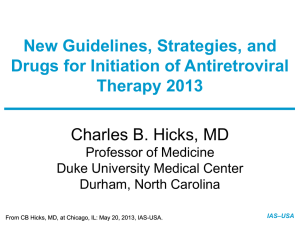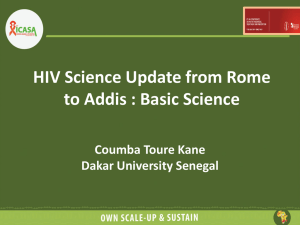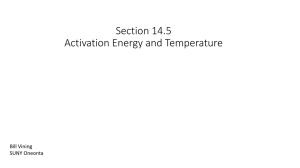PPT
advertisement

Slide 1 of 24 Immune Activation, HIV Persistence, and the Cure Daniel C. Douek, MD, PhD Bethesda, Maryland From DC Douek, MD, at San Francisco, CA: March 24, 2013, IAS-USA. IAS–USA Slide 2 of 24 What We Talk About When We Talk About Immune Activation Immune activation occurs early in infection Virus load Cytokine A.R. Stacey et al JV 2009 Normal innate response to viral infection in the acute phase of the infection From DC Douek, MD, at San Francisco, CA: March 24, 2013, IAS-USA. Slide 3 of 24 What We Talk About When We Talk About Immune Activation As viral load decreases, immune activation persists Innate • Cells: activated phenotype of Macrophages and Dendritic Cells • Cytokines, chemokines: TNF, IL-1, IL-6, IL-8, IL-15, IL-10 • Acute phase proteins: Serum Amyloid A, C-Reactive Protein • Coagulation: D-dimers, Tissue Factor • Fibrosis: Matrix Metalloprotease activation, collagen deposition • Microbial sensors: Lipopolysaccharide Binding Protein, soluble CD14 Adaptive • T cells: increased turnover, exhaustion, low thymic output, virus reservoir • B cells: increased turnover, altered phenotypic profile, hyper-Ig-emia Frequency of activated T cells is a strong predictor of disease progression From DC Douek, MD, at San Francisco, CA: March 24, 2013, IAS-USA. Slide 4 of 24 Causes Of Chronic Immune Activation • Raised cytokine and chemokine levels are a consequence of immune activation • HIV-induced activation of innate immune system (N. Bhardwaj) – When virus load decreases after acute phase, immune activation remains elevated – Virus load alone is a poor predictor of disease progression (Rodriguez JAMA 2006) – Measures of immune activation predict disease progression independent of viral load (Giorgi, Deeks...) – Elite controllers who progress have increased activated CD38+ T cells (Hunt JID 2008) – When virus load is suppressed with ART immune activation still persists and predicts progression • Increased antigen load, bacterial overgrowth, herpes viruses (S. Deeks, P. Hunt) • Translocation of proinflammatory mediators across mucosae From DC Douek, MD, at San Francisco, CA: March 24, 2013, IAS-USA. Slide 5 of 24 Consequences of HIV Infection in GI Tract Loss of tight junctions Mucus CD4 T cell loss Microbial products Enterocyte apoptosis Healthy Gut •Tight epithelial junctions, mucus •Anti-microbial peptides, Abs, cells •Majority of CD4 T cells in body •Cross-talk between microbes and epithelial cells and immune cells HIV-Infected Gut •Massive loss of CD4 T cells •Enteropathy •2-10x increased permeability •Translocation of microbial products •Systemic immune activation From DC Douek, MD, at San Francisco, CA: March 24, 2013, IAS-USA. Slide 6 of 24 gut CD4 depletion enteropathy HIV Tem Tem Tem Tcm Tem Tcm immune activation From DC Douek, MD, at San Francisco, CA: March 24, 2013, IAS-USA. Slide 7 of 24 immune deficiency gut CD4 depletion enteropathy HIV Tem immune activation Tcm Tem low thymic output LT fibrosis T/B cell dysfunction inflammation non-AIDS morbidity tissue damage mortality From DCand Douek, MD, at San Francisco, CA: March 24, 2013, IAS-USA. coagulopathy CMV ??? Slide 8 of 24 immune deficiency gut CD4 depletion enteropathy ART HIV Tem Tem immune activation Tcm Tem Tcm low thymic output LT fibrosis T/B cell dysfunction inflammation non-AIDS morbidity tissue damage mortality From DCand Douek, MD, at San Francisco, CA: March 24, 2013, IAS-USA. coagulopathy CMV ??? Slide 9 of 24 % CD38+DR+ CD8 T cells ART and T Cell Immune Activation 80 P<0.001 P<0.001 60 40 20 0 HIV + Untreated (n=82) HIV + HAART (n=65) HIV – (n=132) Hunt, et al. J Infect Dis. 2003, 2008 and unpublished observations T cell activation declines during long-term ART, but remains elevated, even after many years of viral suppression From DC Douek, MD, at San Francisco, CA: March 24, 2013, IAS-USA. Slide 10 of 24 Markers of Inflammation and GI Dysfunction Predict Mortality Odds of Mortality (4th vs 1st Quartile) Hunt, CROI 2012 SOCA/SCOPE cohorts Markers of inflammation and gut barrier dysfunction predict mortality independently of CD4 count and virus load From DC Douek, MD, at San Francisco, CA: March 24, 2013, IAS-USA. Slide 11 of 24 ART, Immune Activation and CD4 T Cell Recovery Hunt, et al. J Infect Dis. 2003 and unpublished observations Reduced CD4 T cell recovery associated with immune activation From DC Douek, MD, at San Francisco, CA: March 24, 2013, IAS-USA. Slide 12 of 24 When Immune Activation Turns To The Dark Side Good Bad • Anti-viral innate immune response • Target cell generation • Restoration of memory CD4 T cells • HIV replication • Thymic dysfunction • T and B cell exhaustion • Macrophage/DC activation • Cytokine/Chemokine secretion • Lymph node fibrosis • Generalized tissue fibrosis • Coagulation cascade activation • ……… From DC Douek, MD, at San Francisco, CA: March 24, 2013, IAS-USA. %CD38+ memory CD8 T cells Raltegravir Intensification P < 0.0001 P = 0.266 Slide 13 of 24 Intensified Control P = 0.060 P = 0.010 P < 0.0001 Llibre, Buzón, Massanella et al. Antiv Ther 2011 Raltegravir intensification reduces immune activation significantly more than conventional therapy From DC Douek, MD, at San Francisco, CA: March 24, 2013, IAS-USA. Raltegravir Intensification Slide 14 of 24 Raltegravir intensification in 9 subjects resulted in decrease in IUPM and CD8 T cell activation From DC Douek, MD, at San Francisco, CA: March 24, 2013, IAS-USA. Raltegravir Intensification Slide 15 of 24 No association between plasma measures of viral persistence and T cell activation in blood From DC Douek, MD, at San Francisco, CA: March 24, 2013, IAS-USA. Slide 16 of 24 Virus and Immune Activation in Tissues r = 0.65 P = 0.012 Hunt, Yukl and Wong Sheth, Muc Imm 2012 Stronger association between cell-based measures of viral persistence and T cell activation in gut tissues From DC Douek, MD, at San Francisco, CA: March 24, 2013, IAS-USA. Slide 17 of 36 Virus and Immune Activation in Tissues Raltegravir intensification reduces immune activation and HIV RNA levels in gut tissue sites Slide 18 of 24 Ongoing HIV Replication During ART? Although complete inhibition of viral replication is unlikely to be curative, all cure strategies are based on first having achieved complete suppression • Evidence against ongoing HIV replication on ART • Increasing evidence in favor of ongoing replication • Evidence it is associated with immune activation • The source of the sample is key (blood vs tissues) • The assay used to measure virus is critical From DC Douek, MD, at San Francisco, CA: March 24, 2013, IAS-USA. Slide 19 of 24 VISCONTI — Activation and Reservoir HIV-DNA (log10 copies/106 PBMC) 14 subjects who started therapy very early after infection They remained on cART for many years and then therapy was stopped 6 Saez-Cirion et al, in press 5 4 3 2 1 Acute Chronic cART Elite Post-Rx Controllers Controllers PTC did not rebound when cART was stopped Like elite controllers they had low cell-associated HIV DNA But, in contrast, they had very low T cell activation From DC Douek, MD, at San Francisco, CA: March 24, 2013, IAS-USA. Slide 20 of 24 CD8 1.0 r = - 0.56, P = 0.01 0.5 0.0 0 1 2 % Gag-specific IFNg+ IL2+ CD4+ T cells (GALT) % Gag-specific IFNg+ IL2+ CD8+ T cells (GALT) HIV-Specific Immunity and HIV Persistence CD4 6 r = - 0.37, P = 0.12 5 4 3 2 1 0 0 log10 Proviral DNA (per mil PBMC) 1 2 log10 Proviral DNA (per mil PBMC) Hatano JID 2011 On suppressive ART, strong HIV specific T cell responses in the gut mucosa are associated with lower levels of PBMC viral DNA From DC Douek, MD, at San Francisco, CA: March 24, 2013, IAS-USA. immune deficiency Slide 21 of 24 gut ART Tem Tem Tem immune activation Tcm Tem Tcm low thymic output LT fibrosis T/B cell dysfunction inflammation non-AIDS morbidity tissue damage mortality From DCand Douek, MD, at San Francisco, CA: March 24, 2013, IAS-USA. coagulopathy CMV ??? Slide 22 of 24 target cell generation infected cell proliferation virus transcription virus production low thymic output immune activation new infection events From DC Douek, MD, at San Francisco, CA: March 24, 2013, IAS-USA. lymphoid fibrosis poor CD4 T cell renewal T/B cell dysfunction mucosal damage Slide 23 of 24 Therapeutic Interventions in Development • Chemokine receptor inhibitors: • Anti-inflammatory drugs: – maraviroc, TB-652 • Anti-infective therapy: – CMV, EBV, HSV, HCV/HBV • Microbial translocation: – sevelamer, colostrum, rifaximin • Enhance T cell renewal: – Growth Hormone, IL-7 • Anti-fibrotic drugs: – pirfenidone, ACEi, ARBs, KGF • Anti-aging: – caloric restriction, sirtuin activators, vitamin D, omega-3 fatty acids, rapamycin, diet, exercise – – – – – – Chloroquine, HCQ Minocycline NSAIDs (COX-2i, aspirin) Statins Methotrexate Thalidomide, lenalidomide, pentoxyfylline (weak TNF inhibitors) – Biologics (e.g., TNF inhibitors, IL-6 inhibitors, anti-IFNa, anti-PD1 • Anti-coagulants: - low dose warfarin, dabigatran, aspirin, clopidogrel Combination therapy may be necessary From DC Douek, MD, at San Francisco, CA: March 24, 2013, IAS-USA. Slide 24 of 24 In The Context of The Cure • Multiple mechanisms account for HIV persistence, all of which are being addressed therapeutically • The unifying theme is to reduce HIV reservoir size – Reduce inflammation – Increase immune function – Early ART and ART intensification – Gene therapy to reduce reservoir size – Stem cell transplants can reduce reservoir size – Drugs with biologic activity against latent virus exist – Vaccines may enhance host-clearance mechanisms Combination therapy may be necessary From DC Douek, MD, at San Francisco, CA: March 24, 2013, IAS-USA.








